
Guitar maintenance is a very important part of assuring good performance every time the instrument is used. There are many factors in a good guitar care routine. Here are some keys areas to consider when maintaining and caring for your guitars.
Table of contents
Pick up a guitar maintenance kit and care kit
DIY guitar maintenance is easier than ever. Many online guides and videos are available to set you on the right path. A basic toolkit is advantageous for many tasks because it provides the tools you need. By and large, there are two kinds of kits available: a guitar repair kit and a general instrument care kit.
In a guitar repair kit, you can expect to find Allen keys, feeler gauges, small screwdrivers, pliers, and string winders, amongst other tools. This ensemble is good for adjusting and tweaking the guitar as well as changing strings.
A guitar care kit will have polishes and cleaners to help clean and maintain your instrument. The kit will often include a cleaning cloth and perhaps even a neck cradle so you can rest your guilt while caring for it.
Cleaning your guitar
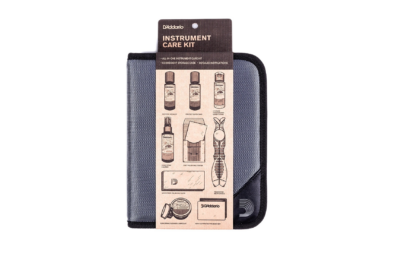
Guitar cleaning is important and yet we often overlook the process. The excitement of playing music can outweigh the effort it takes to give your guitar a quick cleaning. However, it is a necessary process so consider setting some time aside before or after using your guitar, or schedule a general maintenance session.
If you purchase an instrument care kit like I mentioned above, you’ll have the various polishes and cleaners needed to keep your instrument looking and feeling great. I’ll go over a cleaning and care routine you can use to maintain your guitar. Some steps like wiping only take a few seconds, while others like polishing require a bit more time.
Wipe your guitar before and after each use
Good guitar maintenance means cleaning the guitar before and after each use. Using a lint-free cloth, take the time to wipe down the fretboard, strings, and then the body of the instrument before and after every practice or gig. Wiping removes dirt, oils, and grimy dead skin cells that rub off when you were playing.
Opinions vary widely on the subject of wiping your guitar. You can give it a once over before and after each use, or perhaps choose before or after. Some people like less dirt and others like to leave some evidence of a fun gig or rehearsal!
Polishing to maintain and protect the body
Regular polishing is a great way to keep a guitar looking and feeling great. My suggestion is that you use a guitar polish and not furniture polish. Furnisher polish can damage a guitar’s varnish. As a general rule, stay away from it, so you never have a problem. There are a good number of guitar polishes available. You will want to find the right product for your particular guitar.
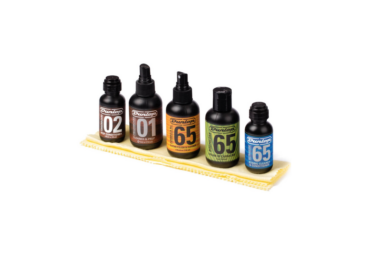
When applying, be careful to spray the polish on the rag and not directly on the guitar. This helps avoid getting the polish on strings, pickups, and other metal parts.
Make sure to use different cloths for wiping and polishing your guitar. The reason why is that you want to avoid putting guitar polish on the fingerboard to prevent the oils from the polish from getting on it. You could use one cloth for the fingerboard only, and another for the rest of the guitar. Or one cloth for wiping and another for polishing, but remember to stay clear of the fingerboard!
Scrubbing the hard-to-reach areas
An old toothbrush can be useful to care for your guitar. Use it to remove dust and dirt from hard-to-reach areas around the pickups and the bridge. When you change your strings, you can give the frets a good cleaning as well.
Polishing metal
For cleaning metal components, a good metal cleaning compound is best. These compounds are mildly abrasive, so be careful not to overuse them. Also, be attentive to avoid applying abrasive polish to the non-metallic (wood) part of the guitar. Chances are it will damage the varnish, spoiling your instrument’s look and value.
Cleaning guitar electronics
Be careful about using any liquids near the electronics such as your pickup and volume/tone controls. I like to use compressed air to clean these areas. Seeing that there is no fluid (only air!), there is no worry that it will damage the electronics.

Managing your guitar’s environment and humidity
A significant area of concern for guitar maintenance is the environment in which the instrument is stored. Good storage conditions offstage and outside the rehearsal room will provide resilience to the guitar for times when it is exposed to less adequate environments. It is indeed difficult to manage a guitar’s environment once it’s out of storage and being used.
Where I live, my guitars face a large range of environmental conditions. In winter, the humidity is quite low and the temperature is cold. In summer, the humidity skyrockets and the temperature can reach scorching highs. Therefore, I need to control my guitars’ surroundings to ensure a proper environment. Thankfully, it is pretty simple to manage. Here are some details to be aware of.
Extreme temperatures
Protect the guitar from prolonged exposure to extreme heat and extreme cold. Severe heat and cold can cause the wood to warp, resulting in damage that is very difficult to repair, and sometimes unrepairable. In my opinion, cold is the worst of the two as it can cause cracking on the finish of the instrumental in addition to warping. Heat can be bad too, particularly with hollow-body acoustic guitars as they are more delicate than solid-body electric guitars. As a guide, I have two simple rules.
First, bring the instrument inside during winter. Some people have a habit of leaving the guitar in the car overnight, for convenience’s sake. The bitter cold will affect your guitar in this case. Avoid it if possible!
Second, ensure that you care for your guitar by storing it in a shady place during outdoor sessions and concerts throughout the summer months. Direct sunlight can cause great damage to the instrument. The instrument can survive a short exposure, but the risk increases greatly the longer it sits in direct sunlight.
Sudden temperature changes
You’ll want to avoid exposing the guitar to sudden temperature changes as well. The guitar will react to the sudden change in the environment. At the very least, the tuning will change. In other cases, damage can occur.
Always give an extra 5-10 minutes for the instrument to acclimatize to its new surroundings. Ideally, let it sit for five minutes inside its case, then take it out for 5 minutes fully exposed prior to rehearsing or playing.
Humidity
This important parameter is often ignored. Too much or too little humidity can cause great fatigue or damage to any guitar. For example, where I live the winters are very dry. To combat the low humidity I try as much as possible to keep my instruments all in one humidified room. I use a humidifier to keep the level of humidity at approximately 50%. Opinions vary on this subject. 50% humidity may be considered too little or too much. However, it seems to work well for my instruments.
On the other hand, it is often very humid where I live during the summer months. Depending on how intense the humidity gets, I like to use a dehumidifier. Often, however, an air-conditioner is enough to reduce the intense humidity in the air, creating a manageable environment for instruments.
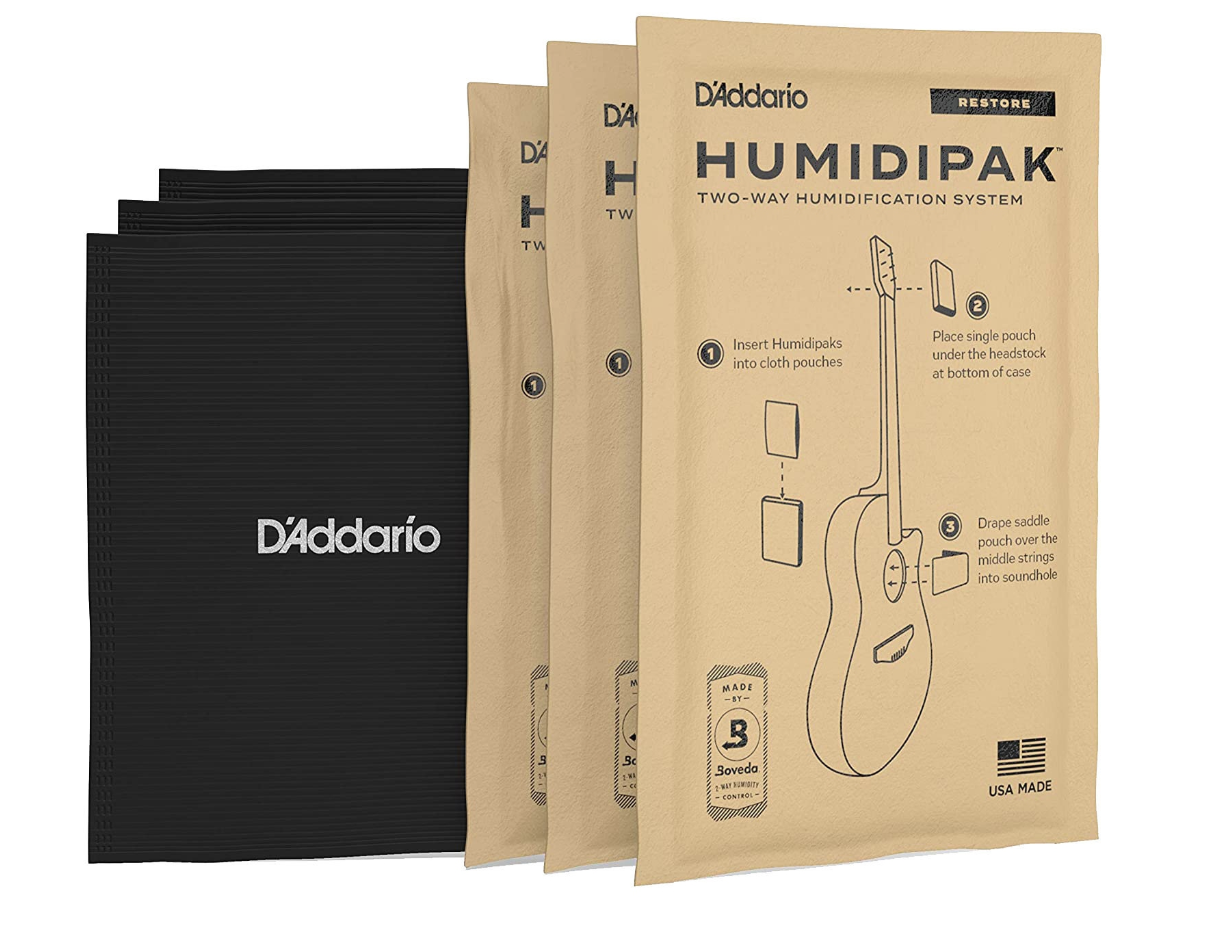
If the guitar is often out of its main storage room, it is a great idea to use a portable humidifying device. I have tried many different products, and my favourites are the ones that can both humidify and dehumidify, according to the moment’s need.
Measuring humidity
Too much or too little humidity can damage your instrument. But how do you measure it? Fortunately, it’s a straightforward exercise. I use a hygrometer to do it. Both traditional and digital versions of hygrometers are available.
Preventative maintenance
Tighten those loose screws
Preventative guitar maintenance is a large element of guitar care. Check often (every month or so) to ensure all screws are tight. Check tuning heads, pickguards, and strap pins, and tighten any loose screws you find. I usually take a brief look at the pickups, to ensure nothing is loose there. This little yet important check-up will save a frustrating search for a missing screw later on. In the case of strap pins, you may even save some damage to the guitar. There’s nothing more unwelcome than the guitar falling mysteriously (and embarrassingly) when a screw comes loose on the strap!
Check volume and tone knobs too
 Maintain your guitar by verifying the condition of the volume and tone knobs. A common issue is a noise inside the knobs when you turn them. Often caused by old or dirty connections, this noise can be super bothersome or even cause non-functioning equipment. At times, the volume and control knobs can be cleaned using a special cleaner. In other cases, a knob may need to be replaced by your luthier.
Maintain your guitar by verifying the condition of the volume and tone knobs. A common issue is a noise inside the knobs when you turn them. Often caused by old or dirty connections, this noise can be super bothersome or even cause non-functioning equipment. At times, the volume and control knobs can be cleaned using a special cleaner. In other cases, a knob may need to be replaced by your luthier.
By examining your knobs you might also notice if they are crooked or damaged. Occasionally you can adjust the placement, but it is probably best to wait until your next luthier’s visit to repair this.
Capos can cause wear and tear
The use and storage of a capo can cause its own problems. On its own, it is a harmless guitar accessory. However, be careful of where the capo is being stored when it’s not in use. If there is any place you should avoid keeping it, it’s on the end of the instrument. It may seem convenient, however, it is actually like adding a hook to the end of the guitar. And when it hooks onto something … well, you don’t want to know the rest of the story.
Capos can cause excessive fret wear over a longer time period. Using an adjustable tension capo can help prolong fret life. Choose a capo that best fits the needs of the guitar, be it electric or acoustic.
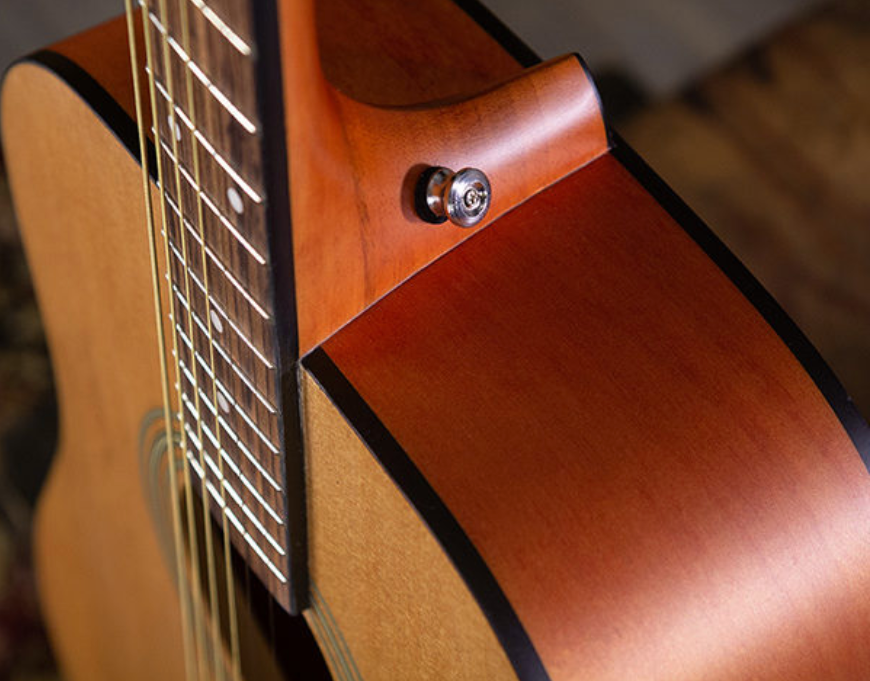
String care
Changing strings
Every guitarist has a different opinion on how often strings should be changed. Regardless of your take on the subject, there are a couple of technical points to think about when the strings do need to be changed. First off, do not remove all of the strings at once. Do 2-3 at a time. This is a good idea because removing all strings at once may cause a sudden drastic change in tension in the instrument. One never knows, but the guitar could react poorly to this change, causing damage.
Wiping strings
Make sure that you wipe both the top and bottom of your strings after each session. Use an old t-shirt or a microfibre cloth. They seem to work best. It’s that simple!
Storing and transporting your guitar
Use a guitar case
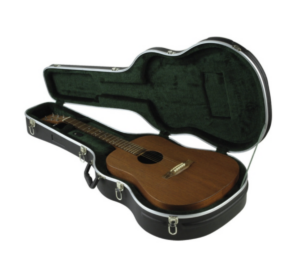 There are different types of guitar cases: solid, semi-rigid, and soft. Choose the type according to your needs and preferences.
There are different types of guitar cases: solid, semi-rigid, and soft. Choose the type according to your needs and preferences.
Hard cases are great when you’re travelling, especially if you’re in a band with lots of heavy equipment. Hard cases also keep humidity more consistent, especially if you use an in-case guitar humidifier.
Soft cases are great for portability, but often offer less protection against bumps and knocks. However, semi-rigid or heavily padded soft cases are also available. They are my personal choice overall, as they can offer good protection and portability. There are many brands and models to choose from for each category.
Guitars stands and hangers are very effective
It is a form of preventative maintenance to keep your guitar on a stand when you are taking a break from rehearsal, leaving your instrument on stage, or have finished your day’s practice session. We certainly do not want the guitar falling over for any reason and a good stand can save much expense and worry compared to leaning the instrument against the amp or in a corner somewhere.
Use a folding stand when on stage. Either a single or 3-way stand is great, depending on your needs. On occasion, a guitar rack with space for 4-5 guitars is useful as well.
Use wall hangers in a humidity-controlled space (important!). They are terrific for storing your guitars at home or in the studio, where you can control the humidity for all your instruments at once.
Professional maintenance
Nothing replaces an experienced guitar technician when caring for your guitar. A good tech is an artisan too, and they really know their stuff. From adjusting truss rods to crowning frets, aligning pickups or cleaning electronics, a guitar technician can take care of it all.
During a visit to my luthier, if any non-urgent issues are discovered, I can discuss a plan for getting things fixed. Any immediate issues are often dealt with on the spot during the “check-up”. I have a few instruments, and taking them all in all of the time is simply too costly. Therefore, I take care of my primary instruments more regularly, worrying about the others when my budget allows.
Other points to consider for good guitar maintenance
- Buy a stand. Prices vary based on your needs, but it’s always money well spent.
- Be aware of what you wear when playing your guitar. That fancy belt buckle you have might just be wearing a big hole through the back of your instrument.
- Organize your cables. Be attentive when you run your cables while in the studio and especially when on stage. Stepping on a cable at best will cause a stumble. Furthermore, you can pull needlessly on the cable input, causing damage.
Get started with your guitar maintenance routine
Use these ideas and tips to begin a guitar maintenance routine for your beloved instruments. There are many matters to consider. So, if you wonder where to begin, choose the simpler procedures first. You will learn and work forward from there. If you need any equipment for your work, Best Buy has a nice selection of everything you will need on their guitars & accessories page.
Do you have any other tips on guitar maintenance? Make sure to share them in the comments!



